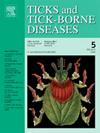Short Communication: Anaplasma phagocytophilum and Babesia spp. in ixodid ticks infesting red foxes (Vulpes vulpes) in Great Britain
IF 3.1
2区 医学
Q2 INFECTIOUS DISEASES
引用次数: 0
Abstract
Red foxes (Vulpes vulpes) are found throughout the United Kingdom (UK), and can reach high population densities in urban areas. They are often infested with ticks which may carry tick-borne pathogens, leading to a risk of transmission to domestic animals and humans. This study investigated the prevalence of tick-borne pathogens in ticks sourced from red fox carcasses across Great Britain between 2018 and 2022. Tick species were identified using morphological keys and molecular barcoding, followed by specific pathogen testing using PCR. In total, 227 ticks were collected from 93 foxes. Pooling (n = 2) was undertaken for unengorged nymphs from the same tick species and fox host, with 203 homogenates tested in total (24 pools and 179 individual ticks). Ixodes hexagonus was the most abundant tick species sampled (73 %), of which 59 % were nymphs and 41 % were females. Less common were Ixodes ricinus (12 %) and Ixodes canisuga (15 %), the majority of which were females (73 % and 91 %, respectively). One Ixodes sp. larva was identified. Babesia DNA was identified in seven individual ticks and once in pooled ticks (n = 2); seven detections were in I. hexagonus and one in I. canisuga, with an overall detection rate of 7 % (95 % CI: 6 − 8 %). Sequence analysis confirmed that all Babesia detections in I. hexagonus were Babesia vulpes, with detection of Babesia Badger Type A in I. canisuga. Screening for Anaplasma phagocytophilum DNA through amplification of the msp2 gene yielded an overall detection rate of 4 % (detected in I. hexagonus only). Louping ill virus was not detected by qRT-PCR in any tick RNA tested. The majority of pathogen detections were in ticks from red foxes in rural areas of the UK, although a small number of Babesia detections were in ticks collected from semi-rural or urban red foxes. Additionally, B. vulpes was detected in GB red fox tissues, suggesting a potential role as a reservoir host. This study confirms the detection of tick-borne pathogens in ticks infesting UK red foxes and highlights the involvement of GB tick species in animal or human disease transmission.
短讯:大不列颠赤狐(Vulpes vulpes)所感染的弓形虫蜱中的噬细胞嗜血杆菌(Anaplasma phagocytophilum)和巴贝西亚原虫(Babesia spp.
红狐(Vulpes vulpes)遍布英国各地,在城市地区的种群密度很高。红狐身上经常有蜱虫,这些蜱虫可能携带蜱媒病原体,有可能传播给家畜和人类。本研究调查了 2018 年至 2022 年期间英国各地红狐尸体上的蜱虫中蜱传病原体的流行情况。研究人员使用形态学密钥和分子条形码鉴定了蜱虫种类,然后使用 PCR 进行了特定病原体检测。总共从 93 只狐狸身上采集到 227 只蜱虫。对来自同一蜱虫物种和狐狸宿主的未脱钩若虫进行了汇集(n = 2),共检测了 203 个匀浆(24 个汇集和 179 个单个蜱虫)。六角伊蚊是取样最多的蜱虫种类(73%),其中 59% 为若虫,41% 为雌性。较少见的是蓖麻蜱(12%)和犬蜱(15%),其中大多数为雌性(分别为 73% 和 91%)。发现了一只 Ixodes sp.幼虫。在 7 只个体蜱虫和 1 只集合蜱虫(n = 2)中发现了巴贝斯虫 DNA;其中 7 只在六角伊蚊中发现,1 只在犬科伊蚊中发现,总检出率为 7 %(95 % CI:6 - 8 %)。序列分析证实,在六角蛙中检测到的所有巴贝西亚原虫都是秃头巴贝西亚原虫,在犬蛙中检测到的是獾型巴贝西亚原虫 A 型。通过扩增 msp2 基因筛查噬细胞蝇疟原虫 DNA,总检出率为 4%(仅在六角蛙中检出)。通过 qRT-PCR 技术,在所有检测的蜱 RNA 中都没有检测到娄平病病毒。大多数病原体都是从英国农村地区的红狐身上检测到的,但也有少量巴贝西亚原虫是从半农村或城市红狐身上采集的蜱虫中检测到的。此外,在 GB 红狐的组织中也检测到了巴贝西亚原虫,这表明红狐有可能是巴贝西亚原虫的宿主。这项研究证实了在侵扰英国红狐的蜱虫中检测到了蜱传病原体,并强调了英国蜱虫物种参与动物或人类疾病传播的可能性。
本文章由计算机程序翻译,如有差异,请以英文原文为准。
求助全文
约1分钟内获得全文
求助全文
来源期刊

Ticks and Tick-borne Diseases
INFECTIOUS DISEASES-MICROBIOLOGY
CiteScore
6.90
自引率
12.50%
发文量
185
审稿时长
6-12 weeks
期刊介绍:
Ticks and Tick-borne Diseases is an international, peer-reviewed scientific journal. It publishes original research papers, short communications, state-of-the-art mini-reviews, letters to the editor, clinical-case studies, announcements of pertinent international meetings, and editorials.
The journal covers a broad spectrum and brings together various disciplines, for example, zoology, microbiology, molecular biology, genetics, mathematical modelling, veterinary and human medicine. Multidisciplinary approaches and the use of conventional and novel methods/methodologies (in the field and in the laboratory) are crucial for deeper understanding of the natural processes and human behaviour/activities that result in human or animal diseases and in economic effects of ticks and tick-borne pathogens. Such understanding is essential for management of tick populations and tick-borne diseases in an effective and environmentally acceptable manner.
 求助内容:
求助内容: 应助结果提醒方式:
应助结果提醒方式:


